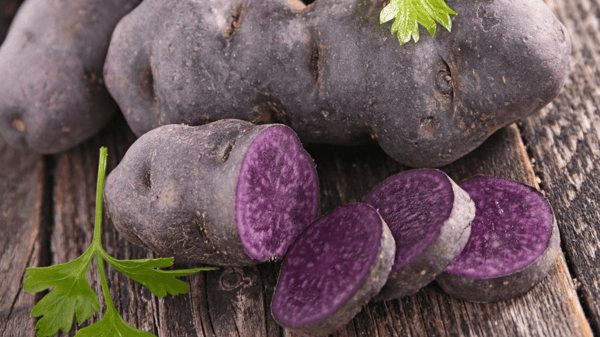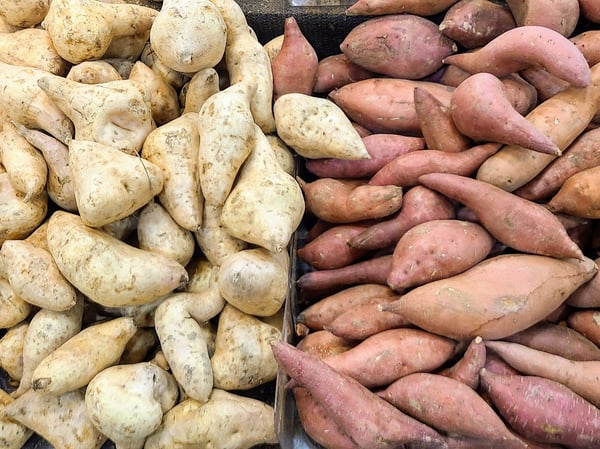Have you seen the purple food craze that has been all over the internet recently? From ice cream to donuts, to cakes and cocktails, very violet food creations are all the rage right now. The culprit responsible for all of these delectable treats is ube. For the uninitiated, ube (pronounced ooh-bae) is a starchy vegetable also as known as a purple yam. But it is not the same as purple sweet potatoes, though they are similar and can be substituted in recipes.
Ube is often confused with Stokes Purple sweet potatoes or Okinawan sweet potatoes which are also purple.

Ube has a creamy, off-white color and vibrant purple inside which can be mistaken for some of its relatives of sweet potato, yuca, and taro root. This tuberous root vegetable originates from Southeast Asia and is a culinary staple in the Philippines, but it’s now cultivated and enjoyed worldwide. The ube is the one on the left and the sweet potato is on the right.

Ube on left and sweet potatoes on right
Speaking of yams and sweet potatoes; I get asked all the time “Are yams and sweet potatoes the same?” The answer is no - yams and sweet potatoes are not the same. Yams have rough, dark brown skin that is often compared to tree bark, and their flesh is dry and starchy like a regular potato. Sweet potatoes have smooth reddish skin, softer flesh (when cooked), and a sweet flavor. Yams grow on vines, while potatoes grow underground. More often than not, even the grocery stores label them wrong!
Ube have a sweet, nutty flavor a bit like a mix of vanilla and pistachio, sweet and earthy and are used in a variety of dishes ranging from sweet to savory. They are loaded with vitamins, minerals, and antioxidants, all of which may benefit your health. Like all veggies, the flavors between each ube plant can vary a bit and can be especially dependent on where it was grown. Larger yams are generally much sweeter than smaller versions, and if a yam has wintered over properly, the starches break down into sugars making the sweet vanilla flavor much more pronounced.
Unlike sweet potatoes, you may have to hunt a little bit to find ube at the store. Your best bet for finding whole ube (and ube products, like frozen ube, ube powder, or extract) is to check out an Asian grocery store but even Trader Joe’s has gotten in on the ube trend and has started to sell ube ice cream and frozen ube. I went to Seafood City Market which is a Filipino grocery store in Chicago that has all sorts of specialty items.
I also decided to make my own version and compare it to the store-bought version. The store-bought version had a more vibrant color compared to mine, but the flavors were very similar.
Ube Halaya
Scroll down for a printable version of this recipe
Yield: 4 cups
Prep time: 20 minutes
Cook time: 1 hour
1 pound frozen grated ube, thawed or 1 pound fresh ube that has been steamed, then peeled and grated (see note below)
1 can (13.5 ounces) coconut milk
1 can (14 ounces) sweetened condensed milk
1 can (12 ounces) evaporated milk
1/2 cup butter
1 cup sugar
1-2 drops ube extract, optional
1. In a wide, heavy-bottomed pan over medium heat, combine grated ube, coconut milk, condensed milk, evaporated milk, butter and sugar.
4. Lower heat and continue to cook, stirring regularly, for about 30 to 40 minutes or until a soft, sticky dough forms.
5. Transfer to jars, molds or a bowl to cool completely.
Notes:
- To thaw frozen ube, defrost in the refrigerator overnight.
- To use fresh ube, first wash it thoroughly, then cover with water and boil until tender, between 30 to 40 minutes. Peel off skin and cut into 1/2-inch cubes (make sure you have 16 ounces). In Step 2, use a potato masher or immersion blender to smooth it out when you’re cooking it. Fresh boiled ube can be frozen in an airtight container for up to 3 months; defrost before using.
Ube halaya is best served cold, which allows its vanilla and pistachio-like flavor to truly shine and makes for a wonderful companion to the Aebleskiver which is traditionally served with a syrup or jam. Now, what is an Aebleskiver, you ask? It is a spherical light airy pancake batter that uses a specific pan and technique. This is the first time I am making them, and let me tell you my that first batch was in typical first pancake fashion - not good. But I adapted and learned how to master the rotation and the heat to finally get some presentable pancakes.
Aebleskiver | Danish Pancakes
Prep Time:10 mins
Cook Time:10 mins
Yield: about 30 pancakes
2 eggs whites and yolks separated
2 cups all-purpose flour
1 Tablespoon sugar
2 teaspoons baking powder
1/2 teaspoon baking soda
1/2 teaspoon salt
4 Tablespoons butter melted, plus extra for the pan
2 cups buttermilk
1. In a medium bowl, beat the egg whites with an electric mixer until stiff peaks form.
3. Gently fold the beaten egg whites into the batter. Batter will be fairly thick.
Ube isn’t only good for satisfying your sweet tooth, though. Of course, you can also bake, roast, fry and mash them, just like you would regular potatoes or sweet potatoes and yams.
There are so many ways to utilize this brightly hued vegetable and for this week's challenge for our private Facebook group, I want to see what root vegetables are adorning your table this fall.
If you are looking for some inspiration on what to do with root vegetables, we have got you covered! From a Thanksgiving Crash Course to Hands-On Vegetarian Boot Camp and a Sweet Potato Gnocchi class offered virtually, you will learn so many creative ways to use root vegetables of all colors.
Join us for our most popular Thanksgiving class - Thanksgiving Crash Course:
- Sunday, November 14 10am Lincoln Square
- Saturday, November 20 10am Merchandise Mart
- Virtual: Saturday, November 20 10am CST
Ube Halaya
Ingredients
- 1 pound frozen grated ube, thawed or 1# fresh ube that has been steamed, then peeled and grated
- 1 can (13.5 ounces) coconut milk
- 1 can (14 ounces) sweetened condensed milk
- 1 can (12 ounces) evaporated milk
- 1/2 cup butter
- 1 cup sugar
- 1-2 drops ube extract, optional
Instructions
- In a wide, heavy-bottomed pan over medium heat, combine grated ube, coconut milk, condensed milk, evaporated milk, butter and sugar.
- Bring to a boil, stirring occasionally until sugar is dissolved, butter is melted, and ube is dispersed.
- Add ube extract, if using, and stir until mixture is evenly colored.
- Lower heat and continue to cook, stirring regularly, for about 30 to 40 minutes or until a soft, sticky dough forms.
- Transfer to jars, molds, or a bowl to cool completely.
